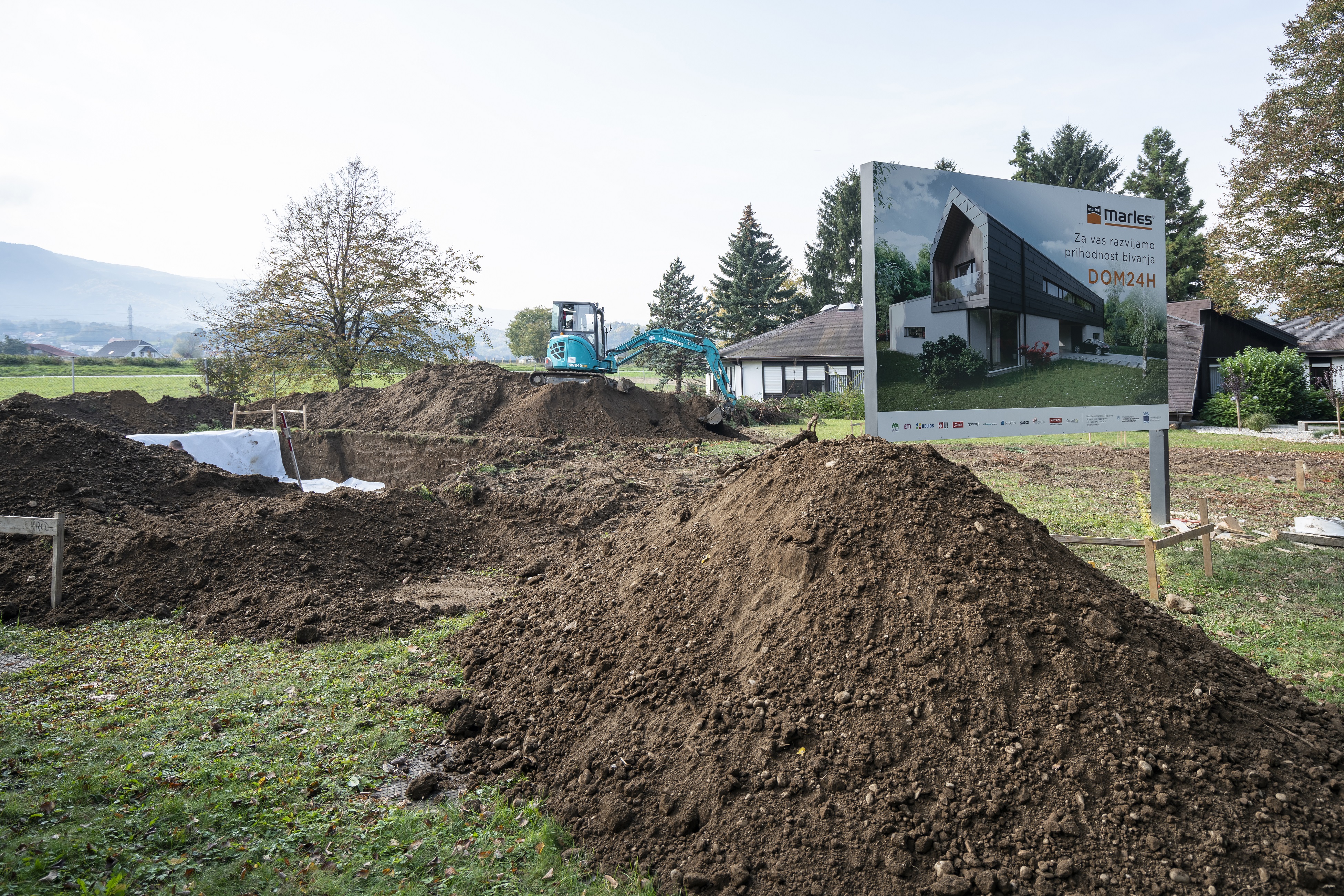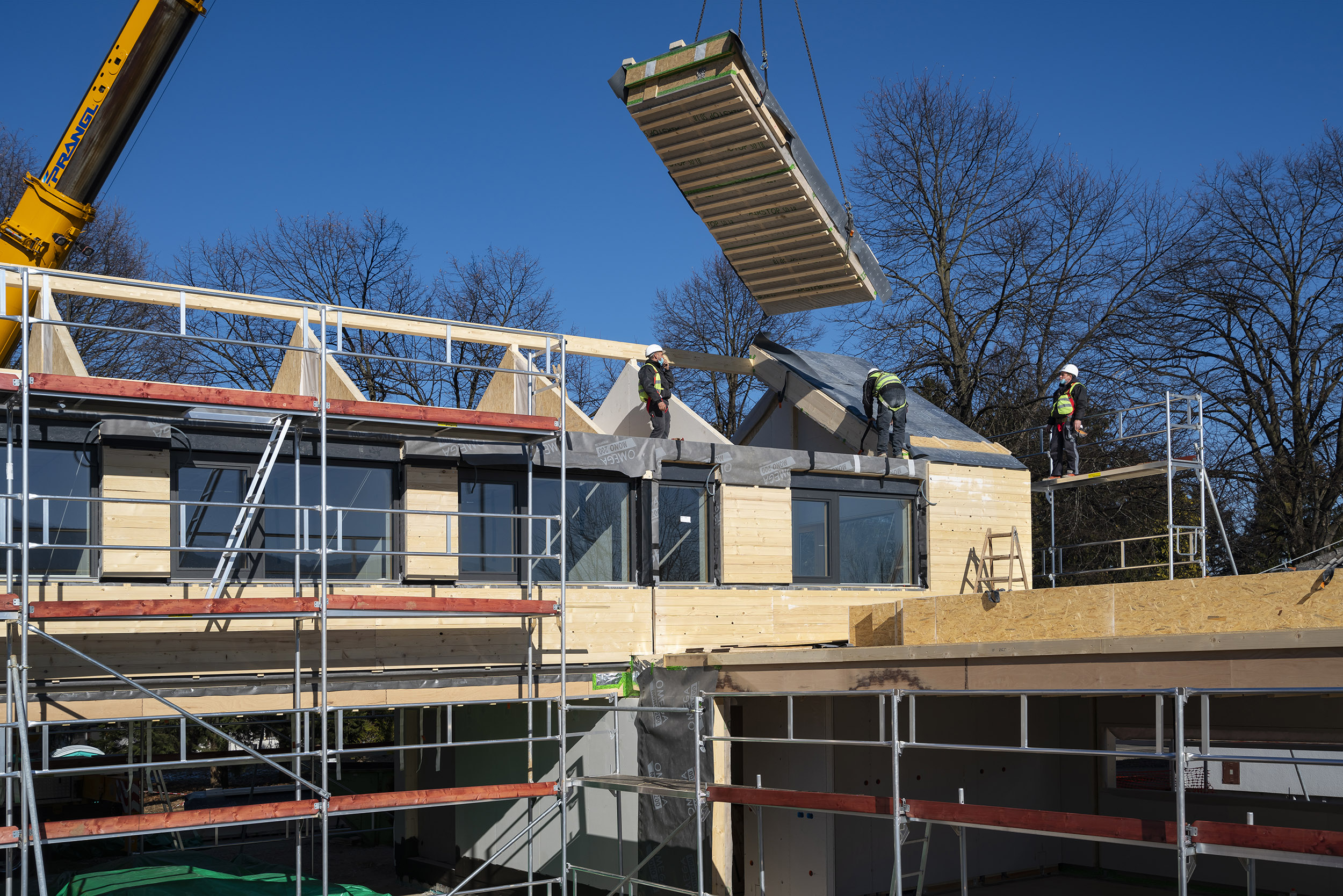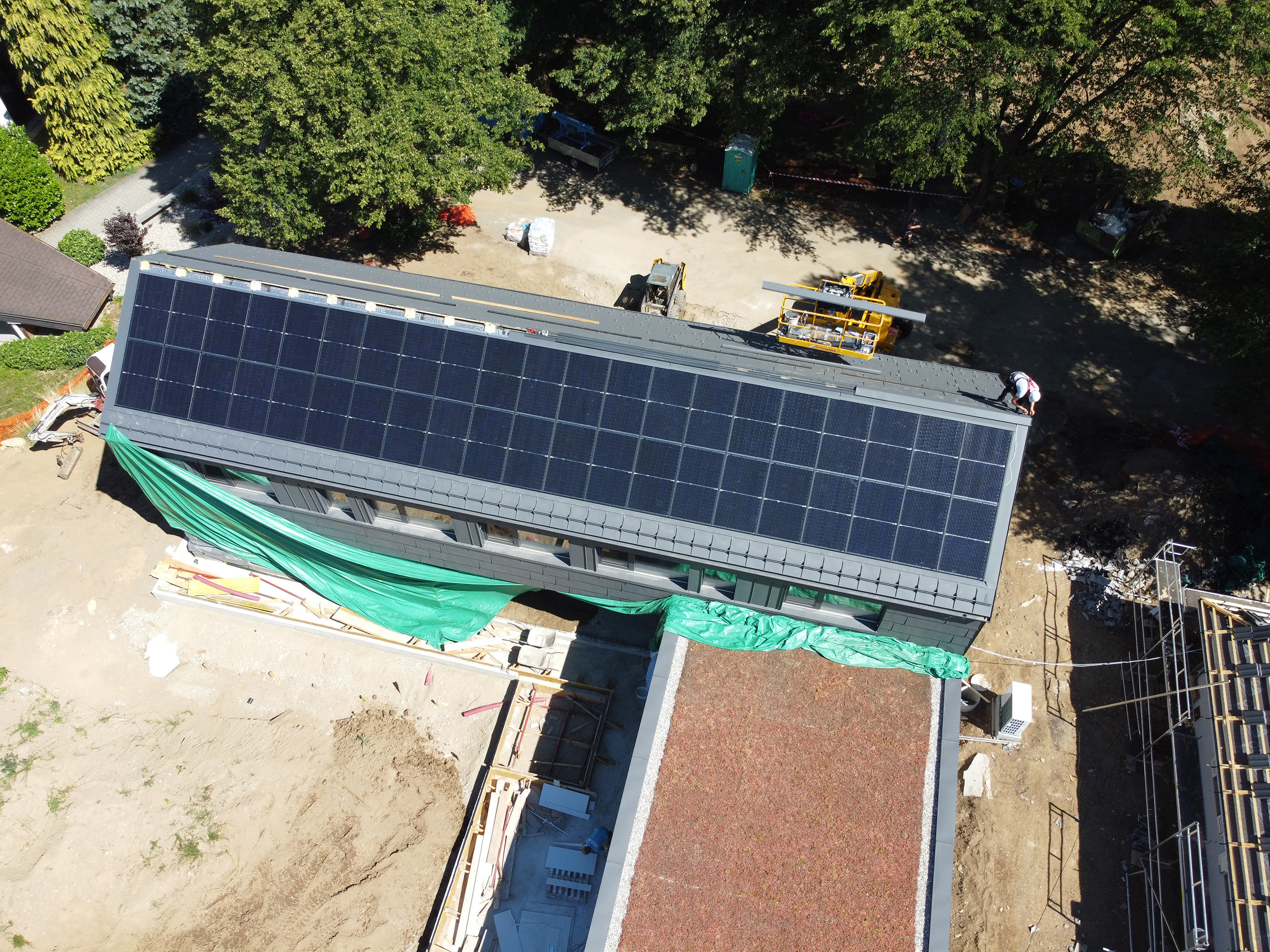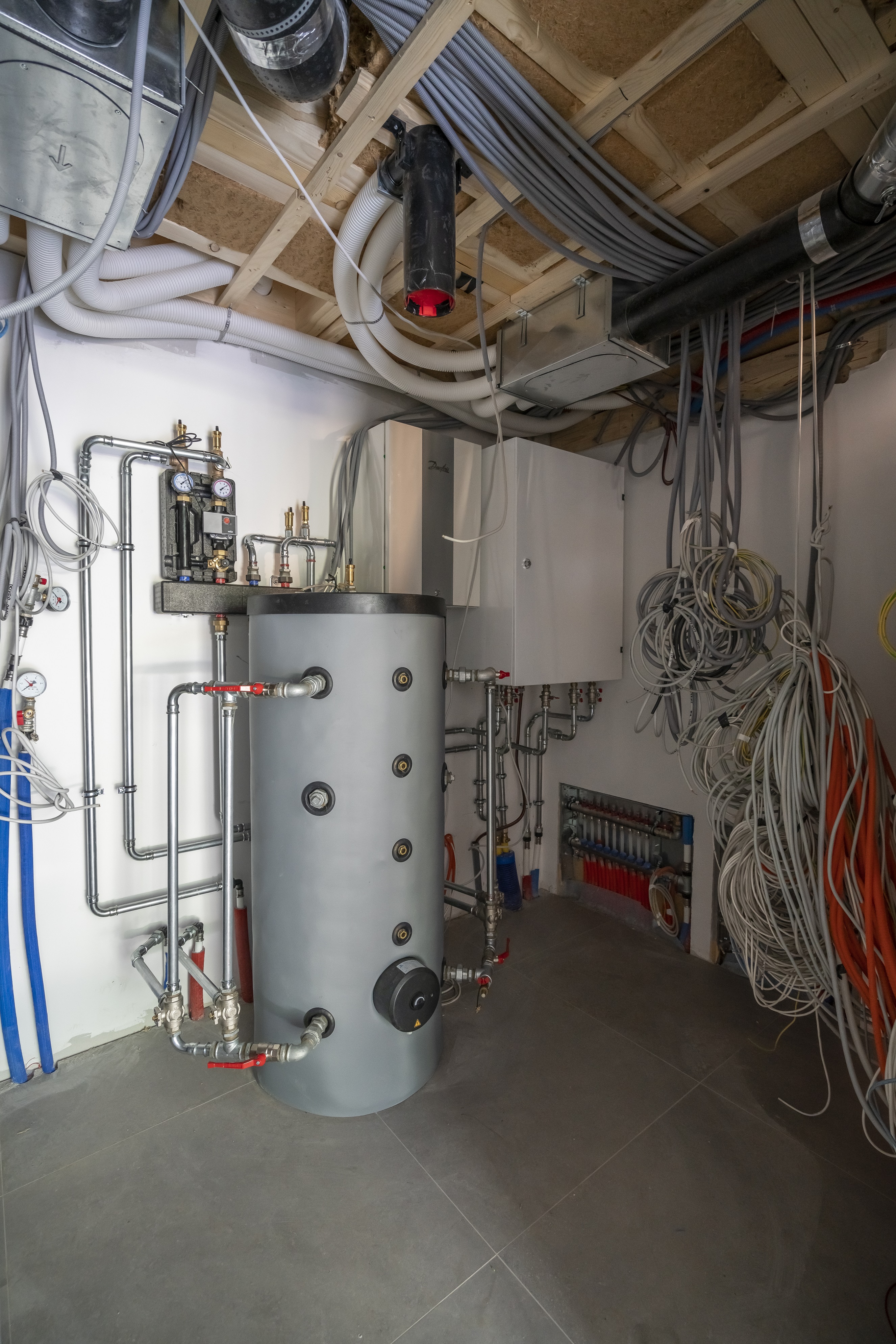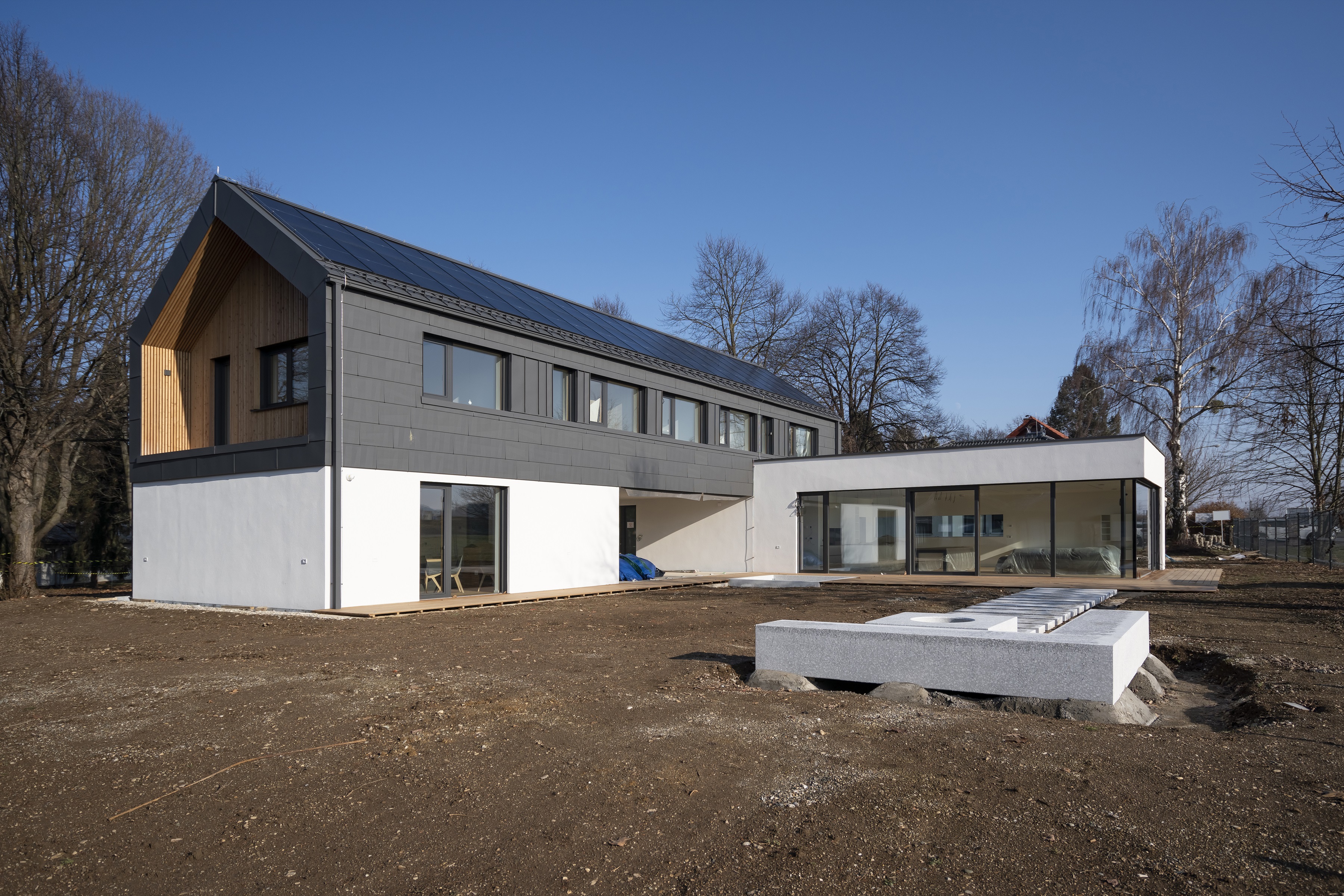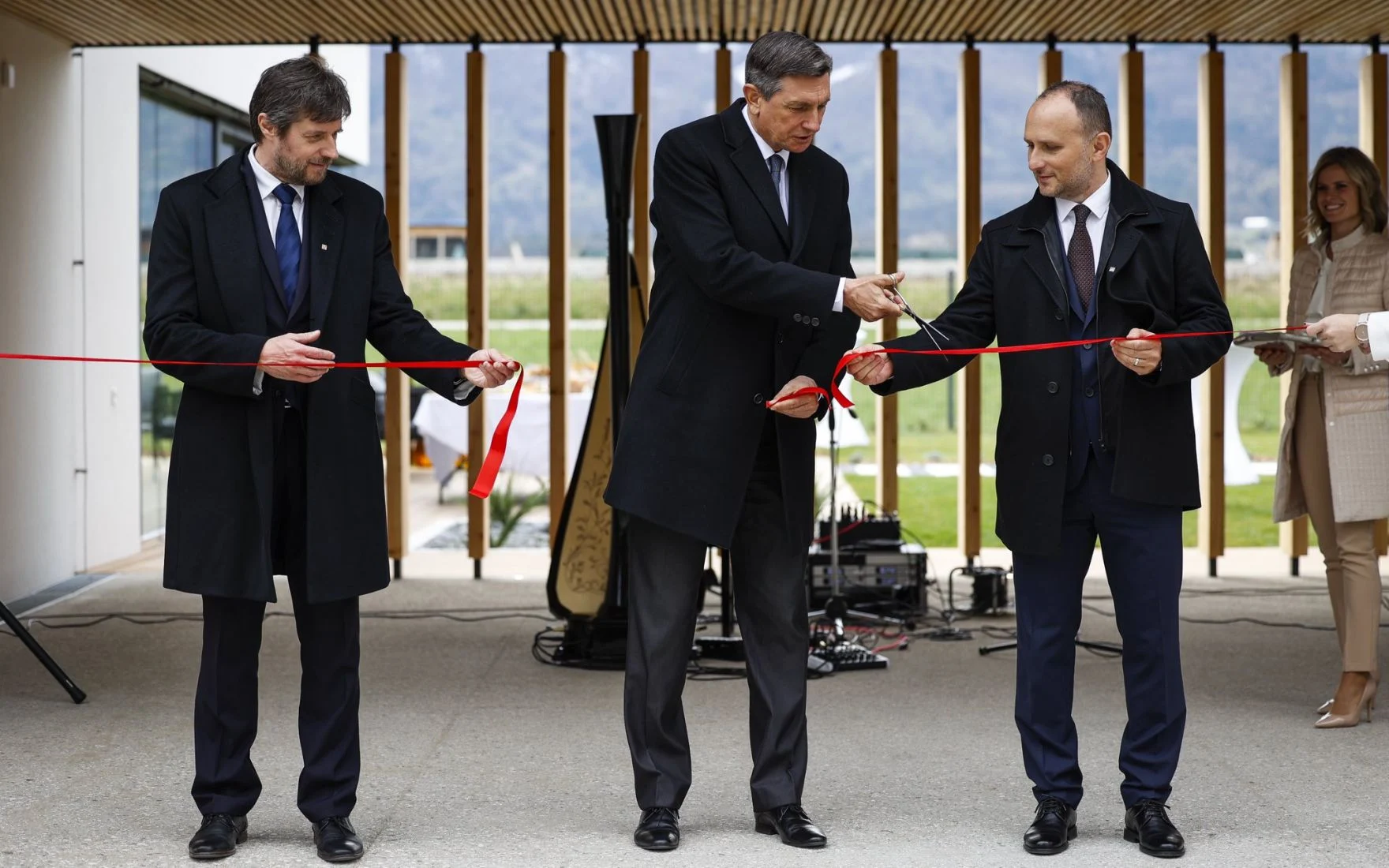Reconnecting with nature
Home24h
Home24h
The construction of a net zero energy house HOME24h represents one of the most modern buildings, which combines the function of living, as well as working from home and active leisure time. The facility is fully supplied with energy and information, includes also mobilty and enables a net-zero energy stay for its users. It is entirely designed in the BiM model, where its digital twin is also designed. With the DOM24h project, we realized one of the biggest achievements of Slovenian companies.
Slovenia
National
It addresses urban-rural linkages
It refers to a physical transformation of the built environment (hard investment)
Yes
2022-03-31
Yes
ERDF : European Regional Development Fund
No
No
As a representative of an organisation, in partnership with other organisations
The overall aim of the project Home24h was to develop a pilot project of a smart home of a future, net-zero home, using natural materials for construction and incorporating cutting edge technologies (IoT, Digital twin, BIM technology in construction) in the process of construction as well as use of a house (e. g. smart appliances, sustainable and sensory interior). The basic purpose of Home24h is the development and demonstration of a new concept of living and working at home which can be used 24 hours per day. It represents the development of subsystems and products for smart buildings of the future.
The design is based on using ecological building materials that improve the comfort of living, ensure thermal stability, reduce energy consumption, extend the lifetime of wooden structures, and reduce the proportion of primary energy. A substantial part of the Home24h’s is designed of natural and recycle materials. Cellulose and wood fibres were used as the main insulation materials, which contribute to a low carbon footprint. To regulate the temperature in children’s room, PMC panels were installed on the celling. PMC is material that, at a certain temperature, increases its mass and consequently the heat capacity of the construction assembly, which, in conclusion, improves thermal comfort in the interior.
Home24h was designed by using BIM technology (Building Information Modelling) that enables designers to jointly construct a building via different software tools. It is a process of creating a building in digital form – from idea to management.
The primary focus of the Home24h project was the development and use of comprehensive technological solutions, smart use of renewable sources, and the incorporation of natural materials.
The target groups are technology enthusiasts and early adopters, environmentally conscious buyers, families and individuals seeking flexible living solutions, real estate investors, elderly populations and business and organizations.
The design is based on using ecological building materials that improve the comfort of living, ensure thermal stability, reduce energy consumption, extend the lifetime of wooden structures, and reduce the proportion of primary energy. A substantial part of the Home24h’s is designed of natural and recycle materials. Cellulose and wood fibres were used as the main insulation materials, which contribute to a low carbon footprint. To regulate the temperature in children’s room, PMC panels were installed on the celling. PMC is material that, at a certain temperature, increases its mass and consequently the heat capacity of the construction assembly, which, in conclusion, improves thermal comfort in the interior.
Home24h was designed by using BIM technology (Building Information Modelling) that enables designers to jointly construct a building via different software tools. It is a process of creating a building in digital form – from idea to management.
The primary focus of the Home24h project was the development and use of comprehensive technological solutions, smart use of renewable sources, and the incorporation of natural materials.
The target groups are technology enthusiasts and early adopters, environmentally conscious buyers, families and individuals seeking flexible living solutions, real estate investors, elderly populations and business and organizations.
- Sustainable building materials
- Integrated Smart solutions
- Net – zero – energy self-sufficient living
- Home – work combination
- Quality of living beyond functionality
Home24h redefines modern living by combining sustainability, smart technology, and adaptable design. It enhances well-being by offering a high-quality living experience that integrates natural materials, energy efficiency, and smart solutions. Designed for flexibility, it adapts to regional, cultural, and individual preferences, allowing partial implementation based on buyers’ needs. Located in Limbuš, next to railway station, with a view of mount Pohorje, it serves as a showcase for contemporary living, hosting business events, students and short-term stays to experience its smart features, fresh air, and comfortable environment.
Sustainability is at the core of Home24h, using ecological materials that improve comfort, ensure thermal stability, and reduce energy consumption. Cellulose and wood fibers are used as primary insulation. PCM panels regulate temperature naturally, while advanced coatings and insulation enhance durability. Water-based coatings protect wooden surfaces inside and out, ensuring longevity and easy maintenance. Rainwater is used to flush the toilets. A significant portion of the furniture is made from recycled materials.
Smart technology optimizes energy use, security, and comfort. Digital Twin automation manages heating, lighting, and maintenance, while smart appliances and predictive heating control enhance efficiency. The home integrates interactive furniture, eco-friendly surface treatments, and a smart pantry system for food management. It not only consumes but also generates and stores energy, with possibility of contributing to community-based energy networks.
Home24h unites 12 Slovenian partners, research institutions, and experts. It promotes inclusivity with smart, accessible, and affordable solutions. Supporting remote work and co-living, it offers a flexible, future-ready lifestyle. With BIM technology and smart automation, Home24h sets a new standard for sustainable, intelligent living.
Sustainability is at the core of Home24h, using ecological materials that improve comfort, ensure thermal stability, and reduce energy consumption. Cellulose and wood fibers are used as primary insulation. PCM panels regulate temperature naturally, while advanced coatings and insulation enhance durability. Water-based coatings protect wooden surfaces inside and out, ensuring longevity and easy maintenance. Rainwater is used to flush the toilets. A significant portion of the furniture is made from recycled materials.
Smart technology optimizes energy use, security, and comfort. Digital Twin automation manages heating, lighting, and maintenance, while smart appliances and predictive heating control enhance efficiency. The home integrates interactive furniture, eco-friendly surface treatments, and a smart pantry system for food management. It not only consumes but also generates and stores energy, with possibility of contributing to community-based energy networks.
Home24h unites 12 Slovenian partners, research institutions, and experts. It promotes inclusivity with smart, accessible, and affordable solutions. Supporting remote work and co-living, it offers a flexible, future-ready lifestyle. With BIM technology and smart automation, Home24h sets a new standard for sustainable, intelligent living.
Home24h blends modern aesthetics with sustainability, creating an eco-friendly and visually appealing living space. Using natural and recycled materials like wooden structures and cellulose insulation, it fosters a warm atmosphere while reinforcing the connection between architecture and nature. The interior features modular and customizable furniture by Alples, ensuring both functionality and aesthetic harmony. Smart furniture with interactive features, such as lighting, sound, and scent diffusion, enhances comfort and well-being.
Advanced technologies optimize the living experience. The Digital Twin Platform allows real-time adjustments to lighting, climate, and energy use, while BIM technology ensures precise design execution, improving durability and visual appeal, and making the maintenance easier. Designed as a net-zero energy home, Home24h integrates smart energy systems like solar panels, energy storage, and heat pumps to minimize environmental impact. Eco-friendly coatings from Kansai Helios and JUB improve air quality and ensure long-term durability.
The design prioritizes well-being through biophilic elements, including natural lighting, optimized acoustics, and high indoor air quality. PCM panels naturally regulate temperature, ensuring thermal comfort with minimal energy consumption. Home24h also supports a seamless blend of work and personal life, offering separated but connected working space. Smart automation, including Gorenje’s connected appliances, simplifies household tasks for greater convenience and efficiency.
Home24h sets a new standard for sustainable housing by merging aesthetics with innovation. Its advanced digital technologies enhance both function and design, while its adaptable spaces cater to diverse social groups and future generations. With a holistic approach, it serves as a model for modern, sustainable living, shaping the future of urban and residential development.
Advanced technologies optimize the living experience. The Digital Twin Platform allows real-time adjustments to lighting, climate, and energy use, while BIM technology ensures precise design execution, improving durability and visual appeal, and making the maintenance easier. Designed as a net-zero energy home, Home24h integrates smart energy systems like solar panels, energy storage, and heat pumps to minimize environmental impact. Eco-friendly coatings from Kansai Helios and JUB improve air quality and ensure long-term durability.
The design prioritizes well-being through biophilic elements, including natural lighting, optimized acoustics, and high indoor air quality. PCM panels naturally regulate temperature, ensuring thermal comfort with minimal energy consumption. Home24h also supports a seamless blend of work and personal life, offering separated but connected working space. Smart automation, including Gorenje’s connected appliances, simplifies household tasks for greater convenience and efficiency.
Home24h sets a new standard for sustainable housing by merging aesthetics with innovation. Its advanced digital technologies enhance both function and design, while its adaptable spaces cater to diverse social groups and future generations. With a holistic approach, it serves as a model for modern, sustainable living, shaping the future of urban and residential development.
The Home24h project is committed to fostering inclusion across multiple dimensions, ensuring accessibility, adaptability, and collaboration.
Home24h stands as a testament to cross-sector collaboration, uniting experts from construction, technology, materials, energy, IT and design industries. This multidisciplinary partnership has been instrumental in developing the cutting-edge pilot Home24h, ensuring that the final product is a well-rounded and innovative solution that addresses various aspects of modern living.
Implementing universal design ensures that the living spaces are accessible and usable by individuals of all ages and abilities and by design adaptability this approach promotes inclusivity for all.
Actively involving future residents and local communities in the design and decision-making processes can ensure that the project aligns with their needs and preferences. This participatory approach enhances a sense of ownership and belonging among residents.
Home24h emphasizes adaptability to different environments, considering local cultural traditions, heritage, and specific needs. The home can be modified to align with diverse cultural contexts and environmental conditions, promoting inclusivity and respect for local customs, geographical features and different social requirements. It can be built in rural and urban areas across different geographical regions.
Recognizing the evolving dynamics of work and life, Home24h integrates living and working spaces to support work-life balance and enhance family interactions. The design includes working space close to living space. This flexibility is different from conventional home designs, which often lack such possibility of close but separate working space.
Technological accessibility, ensuring that smart home technologies are intuitive and user-friendly is crucial. Interfaces are designed for individuals with varying levels of tech-savviness, including the elderly and people with disabilities.
Home24h stands as a testament to cross-sector collaboration, uniting experts from construction, technology, materials, energy, IT and design industries. This multidisciplinary partnership has been instrumental in developing the cutting-edge pilot Home24h, ensuring that the final product is a well-rounded and innovative solution that addresses various aspects of modern living.
Implementing universal design ensures that the living spaces are accessible and usable by individuals of all ages and abilities and by design adaptability this approach promotes inclusivity for all.
Actively involving future residents and local communities in the design and decision-making processes can ensure that the project aligns with their needs and preferences. This participatory approach enhances a sense of ownership and belonging among residents.
Home24h emphasizes adaptability to different environments, considering local cultural traditions, heritage, and specific needs. The home can be modified to align with diverse cultural contexts and environmental conditions, promoting inclusivity and respect for local customs, geographical features and different social requirements. It can be built in rural and urban areas across different geographical regions.
Recognizing the evolving dynamics of work and life, Home24h integrates living and working spaces to support work-life balance and enhance family interactions. The design includes working space close to living space. This flexibility is different from conventional home designs, which often lack such possibility of close but separate working space.
Technological accessibility, ensuring that smart home technologies are intuitive and user-friendly is crucial. Interfaces are designed for individuals with varying levels of tech-savviness, including the elderly and people with disabilities.
The Home24h project embodies New European Bauhaus principles by fostering sustainable, smart, and inclusive housing through participatory engagement and transdisciplinary collaboration. By involving citizens, industry leaders, and researchers, the project ensures technological innovation aligns with user needs, policy goals, and environmental responsibility.
Consultations with end-users refined smart energy management and home automation, ensuring user-friendly and adaptable solutions. Industry leaders, civil society, and research institutions co-created functional and aesthetic aspects of modern living, promoting inclusivity. A broad coalition—including government agencies, private sector partners, and universities—enhanced the project’s impact by integrating architecture, renewable energy, and digital innovation.
Twelve leading Slovenian companies, including Marles, Petrol, Gorenje, and Danfoss, played a key role in merging these elements, aligning with the EU Green Deal to ensure scalability. Engineers, designers, and environmental scientists developed a BIM-based digital twin system to optimize energy efficiency and resource management. The use of circular materials, renewable energy, and IoT-driven automation supports a human-centred, sustainable approach.
The participatory model guarantees accessibility, flexibility, and inclusivity, addressing energy efficiency, remote work adaptability, and smart home automation. Home24h minimizes environmental impact while remaining scalable, demonstrating how interdisciplinary collaboration and stakeholder engagement can create a replicable, future-proof housing model. By integrating beauty, sustainability, and innovation, it showcases how modern housing can enhance quality of life while addressing global challenges.
Consultations with end-users refined smart energy management and home automation, ensuring user-friendly and adaptable solutions. Industry leaders, civil society, and research institutions co-created functional and aesthetic aspects of modern living, promoting inclusivity. A broad coalition—including government agencies, private sector partners, and universities—enhanced the project’s impact by integrating architecture, renewable energy, and digital innovation.
Twelve leading Slovenian companies, including Marles, Petrol, Gorenje, and Danfoss, played a key role in merging these elements, aligning with the EU Green Deal to ensure scalability. Engineers, designers, and environmental scientists developed a BIM-based digital twin system to optimize energy efficiency and resource management. The use of circular materials, renewable energy, and IoT-driven automation supports a human-centred, sustainable approach.
The participatory model guarantees accessibility, flexibility, and inclusivity, addressing energy efficiency, remote work adaptability, and smart home automation. Home24h minimizes environmental impact while remaining scalable, demonstrating how interdisciplinary collaboration and stakeholder engagement can create a replicable, future-proof housing model. By integrating beauty, sustainability, and innovation, it showcases how modern housing can enhance quality of life while addressing global challenges.
At the local level, the project brought together a consortium of 12 prominent Slovenian companies, each contributing specialized expertise in areas such as construction, technology, materials, energy, IT and design. This collaboration ensured a comprehensive development process, integrating diverse perspectives to create a holistic living/working environment. Local communities were also involved, providing insights into user needs and preferences, which informed the design to be community oriented.
On a national scale, the Slovenian government demonstrated strong support for the Home24h project. Notably, in April 2022, then-Prime Minister Mr. Borut Pahor officially inaugurated the Home24h, underscoring the government's endorsement of innovative housing solutions. Additionally, national co-funding was secured, reflecting the project's alignment with national priorities in sustainable development and technological advancement. The support was also shown through the visit of Slovenian Minister of Economy once the Home24h was opened.
At the European level, the project benefited from co-funding opportunities.
Added Value of Stakeholder Engagement:
The multi-level stakeholder engagement in the Home24h project brought significant added value:
• Diverse Expertise: Integrating knowledge from various sectors and regions enriched the project's development, leading to a more robust and innovative outcome.
• Resource Optimization: Collaborative efforts facilitated efficient use of resources, including funding, technology, and human capital, enhancing the project's feasibility and sustainability.
• Broader Impact: Engaging stakeholders at all levels ensured that the project addressed local needs while contributing to regional, national, and European objectives, amplifying its overall impact.
Through this comprehensive stakeholder engagement, the Home24h project set a precedent for collaborative innovation in sustainable living solutions.
On a national scale, the Slovenian government demonstrated strong support for the Home24h project. Notably, in April 2022, then-Prime Minister Mr. Borut Pahor officially inaugurated the Home24h, underscoring the government's endorsement of innovative housing solutions. Additionally, national co-funding was secured, reflecting the project's alignment with national priorities in sustainable development and technological advancement. The support was also shown through the visit of Slovenian Minister of Economy once the Home24h was opened.
At the European level, the project benefited from co-funding opportunities.
Added Value of Stakeholder Engagement:
The multi-level stakeholder engagement in the Home24h project brought significant added value:
• Diverse Expertise: Integrating knowledge from various sectors and regions enriched the project's development, leading to a more robust and innovative outcome.
• Resource Optimization: Collaborative efforts facilitated efficient use of resources, including funding, technology, and human capital, enhancing the project's feasibility and sustainability.
• Broader Impact: Engaging stakeholders at all levels ensured that the project addressed local needs while contributing to regional, national, and European objectives, amplifying its overall impact.
Through this comprehensive stakeholder engagement, the Home24h project set a precedent for collaborative innovation in sustainable living solutions.
The Home24h project was a multidisciplinary initiative project focused on developing a smart, sustainable, and self-sufficient home. By integrating expertise from construction, natural materials, energy efficiency, IT, and sustainability, it optimized resource use, enhanced comfort, and ensured long-term viability.
Key disciplines and contributions:
• Construction: Used prefabrication for fast assembly, offering a flexible and structurally stable design that balances aesthetics and functionality.
• Energy Efficiency: Integrated solar panels, smart energy management (with heat exchange with other Marles buildings), and battery storage to reduce grid dependency and optimize heating, cooling, and lighting.
• IT Solutions: Implemented IoT-enabled smart appliances, a digital twin for real-time optimization, and over 80 sensors to monitor environmental conditions. These include external facade sensors for temperature and moisture measurement, wind sensors, water spill sensors, rainwater regulation and circulation sensors, as well as light, temperature, air quality, and moisture sensors integrated into wooden structures.
• Natural Materials & Healthy Living: Prioritized non-toxic, biodegradable materials, renewable timber, and ventilation systems to enhance air quality and comfort.
• Sustainability & LCA Analysis: Conducted a life cycle assessment to minimize carbon emissions and applied circular economy principles for material recycling.
The project’s success stemmed from synergy among disciplines. Construction and sustainability experts ensured eco-friendly prefabrication. IT and energy specialists developed an intelligent automation system. Health and design expert advised on non-toxic materials for well-being. Environmental analysts minimized the carbon footprint.
Outcomes:
- An energy-efficient, smart, and self-sufficient home
- A healthy indoor promoting well-being
- Sustainable resource use with minimal ecological impact
Key disciplines and contributions:
• Construction: Used prefabrication for fast assembly, offering a flexible and structurally stable design that balances aesthetics and functionality.
• Energy Efficiency: Integrated solar panels, smart energy management (with heat exchange with other Marles buildings), and battery storage to reduce grid dependency and optimize heating, cooling, and lighting.
• IT Solutions: Implemented IoT-enabled smart appliances, a digital twin for real-time optimization, and over 80 sensors to monitor environmental conditions. These include external facade sensors for temperature and moisture measurement, wind sensors, water spill sensors, rainwater regulation and circulation sensors, as well as light, temperature, air quality, and moisture sensors integrated into wooden structures.
• Natural Materials & Healthy Living: Prioritized non-toxic, biodegradable materials, renewable timber, and ventilation systems to enhance air quality and comfort.
• Sustainability & LCA Analysis: Conducted a life cycle assessment to minimize carbon emissions and applied circular economy principles for material recycling.
The project’s success stemmed from synergy among disciplines. Construction and sustainability experts ensured eco-friendly prefabrication. IT and energy specialists developed an intelligent automation system. Health and design expert advised on non-toxic materials for well-being. Environmental analysts minimized the carbon footprint.
Outcomes:
- An energy-efficient, smart, and self-sufficient home
- A healthy indoor promoting well-being
- Sustainable resource use with minimal ecological impact
The Home24h project distinguishes itself from mainstream practices through its innovative integration of smart home technologies and the seamless combination of living and working spaces.
1. Advanced Smart Home Integration:
Digital Twin Technology: Home24h employs a Digital Twin platform that consolidates sensory data into a single application, providing real-time insights and 3D visualization. This integration enhances oversight of infrastructure and resources, reduces maintenance costs, and extends the home's longevity—features not commonly found in standard smart home implementations.
Comprehensive System Management: Beyond basic automation, the project offers advanced functionalities such as documentation management and service request handling within the app, providing a holistic approach to home management that surpasses typical smart home capabilities.
2. Energy Efficiency and Renewable Energy Utilization:
Home24h incorporates energy-efficient building elements and systems, including a photovoltaic power plant and an energy storage unit, to optimize energy consumption and promote sustainability.
A green roof provides insulation, reduces heat loss in winter and overheating in summer, absorbs rainwater, and supports urban wildlife. Two car charging stations ensure mobility independence.
3. Seamless Integration of Living and Working Spaces:
Dual-Purpose Design: Home24h is designed to function as both a residence and a workplace 24 hours a day. The workspace is separate from the living space but close and connected by a canopy. This design caters to the increasing prevalence of remote work, offering a practical solution that supports productivity without compromising on the comforts of home.
By pioneering these approaches, Home24h sets a new standard in residential design, addressing contemporary demands for smart technology integration and the blending of living and working environments in ways that mainstream practices have yet to embrace.
1. Advanced Smart Home Integration:
Digital Twin Technology: Home24h employs a Digital Twin platform that consolidates sensory data into a single application, providing real-time insights and 3D visualization. This integration enhances oversight of infrastructure and resources, reduces maintenance costs, and extends the home's longevity—features not commonly found in standard smart home implementations.
Comprehensive System Management: Beyond basic automation, the project offers advanced functionalities such as documentation management and service request handling within the app, providing a holistic approach to home management that surpasses typical smart home capabilities.
2. Energy Efficiency and Renewable Energy Utilization:
Home24h incorporates energy-efficient building elements and systems, including a photovoltaic power plant and an energy storage unit, to optimize energy consumption and promote sustainability.
A green roof provides insulation, reduces heat loss in winter and overheating in summer, absorbs rainwater, and supports urban wildlife. Two car charging stations ensure mobility independence.
3. Seamless Integration of Living and Working Spaces:
Dual-Purpose Design: Home24h is designed to function as both a residence and a workplace 24 hours a day. The workspace is separate from the living space but close and connected by a canopy. This design caters to the increasing prevalence of remote work, offering a practical solution that supports productivity without compromising on the comforts of home.
By pioneering these approaches, Home24h sets a new standard in residential design, addressing contemporary demands for smart technology integration and the blending of living and working environments in ways that mainstream practices have yet to embrace.
The Home24h approach integrated advanced technologies, sustainable practices, and user-focused solutions to address modern living challenges.
1. Pilot Project Implementation: Home24h was a pilot project, functioning as a testbed for innovative solutions in sustainable living. This approach allowed for the practical implementation and evaluation of new technologies and methodologies, providing valuable insights for future developments.
2. Life Cycle Assessment (LCA): A LCA was conducted to evaluate the environmental impacts of the building throughout its entire life cycle. This analysis informed decisions on material selection, construction processes, and operational strategies to minimize ecological footprints.
3. Internet of Things (IoT) Integration: The project utilized the latest IoT technology to connect and manage various devices within the home. This interconnected system enables real-time monitoring and control, enhancing energy efficiency, security, and user convenience.
4. Digital Twin Development: A digital twin of the home was established in the cloud, allowing for simulation and optimization of the home's operations. This virtual model facilitates predictive maintenance, performance monitoring, and informed decision-making processes.
5. Presence and Access Management: An advanced solution for occupant presence detection and access control was implemented using sophisticated readers and controllers. This system ensured security while providing seamless access management tailored to user preferences.
6. Measuring Remote Work Effectiveness: Solutions were developed to measure time spent on projects as a metric for evaluating the effectiveness of remote work. This feature supports residents in managing work-life balance and productivity within the home environment.
The Home24h project established a replicable model for future residential developments, demonstrating how advanced technology and sustainable practices can be combined.
1. Pilot Project Implementation: Home24h was a pilot project, functioning as a testbed for innovative solutions in sustainable living. This approach allowed for the practical implementation and evaluation of new technologies and methodologies, providing valuable insights for future developments.
2. Life Cycle Assessment (LCA): A LCA was conducted to evaluate the environmental impacts of the building throughout its entire life cycle. This analysis informed decisions on material selection, construction processes, and operational strategies to minimize ecological footprints.
3. Internet of Things (IoT) Integration: The project utilized the latest IoT technology to connect and manage various devices within the home. This interconnected system enables real-time monitoring and control, enhancing energy efficiency, security, and user convenience.
4. Digital Twin Development: A digital twin of the home was established in the cloud, allowing for simulation and optimization of the home's operations. This virtual model facilitates predictive maintenance, performance monitoring, and informed decision-making processes.
5. Presence and Access Management: An advanced solution for occupant presence detection and access control was implemented using sophisticated readers and controllers. This system ensured security while providing seamless access management tailored to user preferences.
6. Measuring Remote Work Effectiveness: Solutions were developed to measure time spent on projects as a metric for evaluating the effectiveness of remote work. This feature supports residents in managing work-life balance and productivity within the home environment.
The Home24h project established a replicable model for future residential developments, demonstrating how advanced technology and sustainable practices can be combined.
The Home24h project serves as a replicable model for smart, sustainable living, adaptable to various environments—both urban and rural, at local and global levels.
A flexible design allows for customization to accommodate diverse spatial needs, settings, and cultural preferences. Prefabricated components enable efficient assembly, reducing construction time and costs while ensuring high-quality production standards. The solutions developed within the Home24h project can be fully or partially replicated, providing adaptability to individual requirements and capabilities.
The project prioritizes the use of locally sourced, natural, and recycled materials, such as wood-based structures and cellulose insulation, supporting both sustainability and local economies. These materials enhance energy efficiency and resilience, ensuring climate adaptability across different environments.
Home24h integrates smart appliances and automation systems with a focus on interoperability, ensuring seamless compatibility with various infrastructures. The user-centric design enhances comfort by adapting to diverse cultural and individual needs, promoting accessibility and ease of use.
The project employs adaptable energy solutions, including solar panels, heat pumps, and storage systems, which can be tailored to local energy resources and climate conditions. Additionally, these systems are designed to comply with local building codes and energy regulations.
Customization of the home’s design allows it to reflect local cultural preferences, increasing community acceptance. A participatory approach involving stakeholders ensures the project aligns with the specific needs and expectations of the communities it serves.
To promote global replication, insights from Home24h are shared through workshops, publications, and partnerships. The model fosters capacity building by developing expertise in sustainable housing, contributing to the advancement of smart, eco-friendly living solutions.
A flexible design allows for customization to accommodate diverse spatial needs, settings, and cultural preferences. Prefabricated components enable efficient assembly, reducing construction time and costs while ensuring high-quality production standards. The solutions developed within the Home24h project can be fully or partially replicated, providing adaptability to individual requirements and capabilities.
The project prioritizes the use of locally sourced, natural, and recycled materials, such as wood-based structures and cellulose insulation, supporting both sustainability and local economies. These materials enhance energy efficiency and resilience, ensuring climate adaptability across different environments.
Home24h integrates smart appliances and automation systems with a focus on interoperability, ensuring seamless compatibility with various infrastructures. The user-centric design enhances comfort by adapting to diverse cultural and individual needs, promoting accessibility and ease of use.
The project employs adaptable energy solutions, including solar panels, heat pumps, and storage systems, which can be tailored to local energy resources and climate conditions. Additionally, these systems are designed to comply with local building codes and energy regulations.
Customization of the home’s design allows it to reflect local cultural preferences, increasing community acceptance. A participatory approach involving stakeholders ensures the project aligns with the specific needs and expectations of the communities it serves.
To promote global replication, insights from Home24h are shared through workshops, publications, and partnerships. The model fosters capacity building by developing expertise in sustainable housing, contributing to the advancement of smart, eco-friendly living solutions.
The Home24h project tackles several critical global challenges by providing innovative, local solutions that can be replicated on a broader scale. Through its sustainable design, smart technology integration, and energy efficiency, it contributes to a more resilient, eco-friendly and future-ready living.
Climate Change and Carbon Emissions
🔹 Challenge: Rising global temperatures and increased carbon emissions from the construction and housing sector.
🔹 Solution: Home24h is a net-zero energy building, integrating solar panels, heat pumps, green roof and energy storage to minimize environmental impact. The use of timber-based materials and recycled materials for interior significantly reduces its carbon footprint, aligning with EU Green Deal goals.
Energy Efficiency and Resource Management
🔹 Challenge: High energy consumption in buildings contributes to fossil fuel dependency and inefficient resource use.
🔹 Solution: Home24h employs smart energy management systems, BIM technology, and Digital Twin solutions to optimize heating, cooling, and electricity consumption, reducing waste and improving energy autonomy.
Sustainable Urbanization and Housing Shortages
🔹 Challenge: Rapid urbanization demands affordable, adaptable, and eco-friendly housing.
🔹 Solution: Home24h offers a prefabricated, scalable housing model that can be adapted for various climates, supporting sustainable city planning.
Digital Transformation
🔹 Challenge: The need for intelligent, connected homes to improve living standards and efficiency.
🔹 Solution: Home24h integrates smart automation, IoT-driven appliances, and AI-based home management, enhancing convenience, security and energy efficiency.
Work-Life Balance &Well-Being
🔹 Challenge: The global shift toward remote work has increased the demand for homes that support productivity and comfort.
🔹 Solution: Home24h provides comfortable workspace, smart automation, and well-being-focused design, creating an efficient environment
Climate Change and Carbon Emissions
🔹 Challenge: Rising global temperatures and increased carbon emissions from the construction and housing sector.
🔹 Solution: Home24h is a net-zero energy building, integrating solar panels, heat pumps, green roof and energy storage to minimize environmental impact. The use of timber-based materials and recycled materials for interior significantly reduces its carbon footprint, aligning with EU Green Deal goals.
Energy Efficiency and Resource Management
🔹 Challenge: High energy consumption in buildings contributes to fossil fuel dependency and inefficient resource use.
🔹 Solution: Home24h employs smart energy management systems, BIM technology, and Digital Twin solutions to optimize heating, cooling, and electricity consumption, reducing waste and improving energy autonomy.
Sustainable Urbanization and Housing Shortages
🔹 Challenge: Rapid urbanization demands affordable, adaptable, and eco-friendly housing.
🔹 Solution: Home24h offers a prefabricated, scalable housing model that can be adapted for various climates, supporting sustainable city planning.
Digital Transformation
🔹 Challenge: The need for intelligent, connected homes to improve living standards and efficiency.
🔹 Solution: Home24h integrates smart automation, IoT-driven appliances, and AI-based home management, enhancing convenience, security and energy efficiency.
Work-Life Balance &Well-Being
🔹 Challenge: The global shift toward remote work has increased the demand for homes that support productivity and comfort.
🔹 Solution: Home24h provides comfortable workspace, smart automation, and well-being-focused design, creating an efficient environment
The Home24h project has delivered significant technological and societal benefits by redefining modern living with smart technologies, sustainable materials, and energy-efficient solutions.
Key Achievements:
1. Net-Zero Energy Smart Home
Located in Limbuš, Slovenia, Home24h serves as a model house for customers and partners. It is energy self-sufficient, integrating solar panels, heat pumps, battery storage, and smart energy management to reduce carbon footprint and energy costs.
2. Advanced Smart Home Technologies
BIM and Digital Twin enable real-time monitoring, predictive maintenance, and optimized energy use. Gorenje’s smart appliances and Robotina’s automation systems provide seamless control over lighting, climate, and security.
3. Sustainable and Eco-Friendly Materials
The home uses wood-based insulation, low-VOC coatings from Kansai Helios and JUB, and PCM panels for thermal stability, improving indoor air quality and reducing energy consumption.
4. Well-Being and Work-Life Balance
Separate but connected workspace supports remote work, creativity, and productivity. SmartIS and Špica developed digital tools for home-office management, reducing stress and enhancing efficiency.
Beneficiaries & Long-Term Impact:
Homeowners benefit from energy savings and comfort, while businesses gain expertise in sustainable housing. Local and national governments align with EU green energy goals, supporting urban sustainability. Future homebuyers and the environment profit from eco-friendly standards, promoting the circular economy.
Home24h demonstrates best practices in sustainable construction. It serves as a model for future smart housing, influencing EU policies on green building and strengthening Slovenia’s position in the global smart building market.
With Home24h, sustainable and smart living is no longer a vision but a reality.
Key Achievements:
1. Net-Zero Energy Smart Home
Located in Limbuš, Slovenia, Home24h serves as a model house for customers and partners. It is energy self-sufficient, integrating solar panels, heat pumps, battery storage, and smart energy management to reduce carbon footprint and energy costs.
2. Advanced Smart Home Technologies
BIM and Digital Twin enable real-time monitoring, predictive maintenance, and optimized energy use. Gorenje’s smart appliances and Robotina’s automation systems provide seamless control over lighting, climate, and security.
3. Sustainable and Eco-Friendly Materials
The home uses wood-based insulation, low-VOC coatings from Kansai Helios and JUB, and PCM panels for thermal stability, improving indoor air quality and reducing energy consumption.
4. Well-Being and Work-Life Balance
Separate but connected workspace supports remote work, creativity, and productivity. SmartIS and Špica developed digital tools for home-office management, reducing stress and enhancing efficiency.
Beneficiaries & Long-Term Impact:
Homeowners benefit from energy savings and comfort, while businesses gain expertise in sustainable housing. Local and national governments align with EU green energy goals, supporting urban sustainability. Future homebuyers and the environment profit from eco-friendly standards, promoting the circular economy.
Home24h demonstrates best practices in sustainable construction. It serves as a model for future smart housing, influencing EU policies on green building and strengthening Slovenia’s position in the global smart building market.
With Home24h, sustainable and smart living is no longer a vision but a reality.

